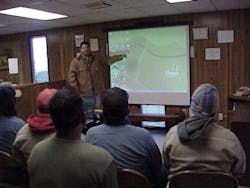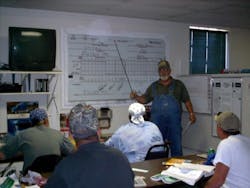Truckers skeptical about new driver training proposal
Reaction to the entry-level driver training proposal just published by the Federal Motor Carrier Safety Administration has been generally supportive from the trucking industry—no surprise, since many big trade groups had a hand in writing it—but drivers are considerably more critical, at least based on the reaction of AmericanTrucker.com readers.
Other than quite a few short-but-not-so-sweet reactions like “joke,” and “big disgrace”—and a very few “about time” and “great idea”—many comments emphasize that learning to drive only just begins when a trucker gets his CDL. Carrier training programs can be hit-or-miss, in terms of the amount of true training is involved—compared, basically, to driving team for a training wage.
Some commenters say 30 hours behind the wheel is not enough, while others worry that trucking companies will use the new standards as an excuse to cut back on their own training programs. And several suggest that beginning drivers who meet this new training standard should be paid more.
But ultimately, training a driver is more an art than a science, because every student is different—and the good trainers should recognize and teach accordingly. Training standards should about safety, the drivers agree—but are they?
“Extra training, exams, pre-trips, obstacle courses. BFD! It's a controlled environment,” says Dennis Arrends on the American Trucker Facebook page. “When you pass all that and ride with your trainer for the duration and then go out on your own, problem solving and time management skills and attitude will play a big part if driver is successful. If driver has a flawed character, it will bubble to the top and show its true colors. These drivers always have problems, create problems and are the problem out there. A good trainer should be able to spot this. But the pressure of running them drivers through is a reality. And so on and so on.”Eddie McMahan says the rulemaking proposal “totally dropped the ball.”
“Where we were saying entry-level driver training, we were talking after-hire, not schooling. It will actually be worse because companies will consider this as adequate training and will not follow up with trainer they will be set out on their own.”
R, Bryan Spoon looks on the bright side: “Well it may not be enough but it's a start, considering the current standard is ZERO. This is just the training required for getting the license. There is a set curriculum also attached to those driving hours. It will at a minimum put the ‘get your CDL in A DAY’ programs out of business.”
Matthew Velazquez was among those calling for even more BTW time: “Thirty hours is not enough. Most drivers do that in half a week. Make the required time something that would take 2 months to complete then you can say you are improving driver safety.”
Jason Everhart has concerns about the re-training requirements in the proposal: “The problem I have is 50 hours is still not quite enough time. Plus, if you read the article you'd see where if for any reason us current CDL holders have our license canceled for whatever reason, we too would have to go through their ‘for profit’ training to obtain our license again. Even if we've been turning a wheel for 20 years.”
Deryl E. Switzer suggests more practical, mechanical skills should be required: “I think on your pre trip you should actually have to adjust your brakes know the measurement for each axle. Actually check your tire pressure. Be able to install a set of wipers. And actually check hub oil. And Level 1-2-3 DOT inspection should require you to have a tool box with a minimal tool list.”
Paul Bazydlo apparently has been paying attention to postings in the Federal Register: “So are we taking bets which mega carrier applies for and receives an exemption from this rule, from the FMCSA?”
About the Author
Kevin Jones 1
Editor
Kevin has served as editor-in-chief of Trailer/Body Builders magazine since 2017—just the third editor in the magazine’s 60 years. He is also editorial director for Endeavor Business Media’s Commercial Vehicle group, which includes FleetOwner, Bulk Transporter, Refrigerated Transporter, American Trucker, and Fleet Maintenance magazines and websites.

